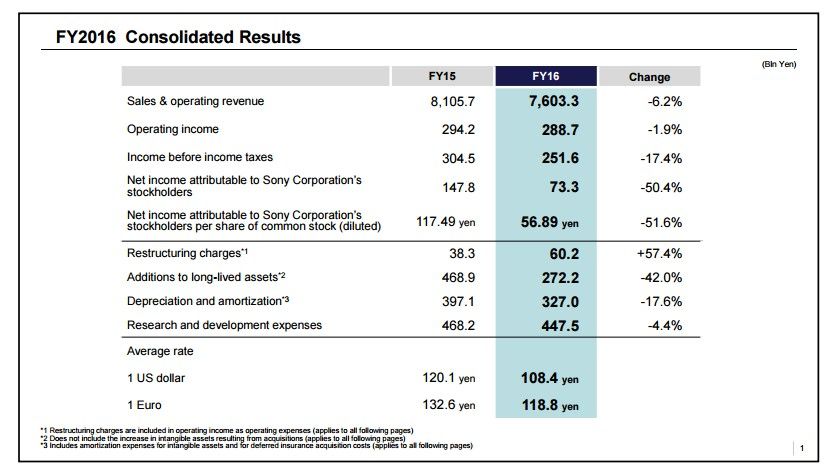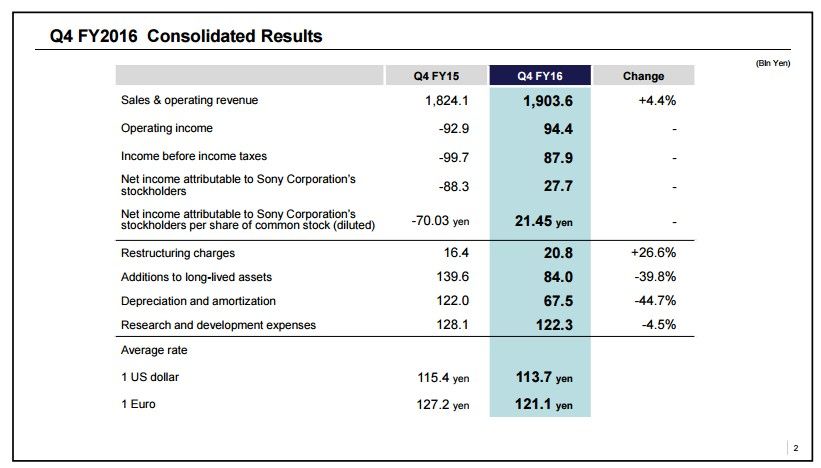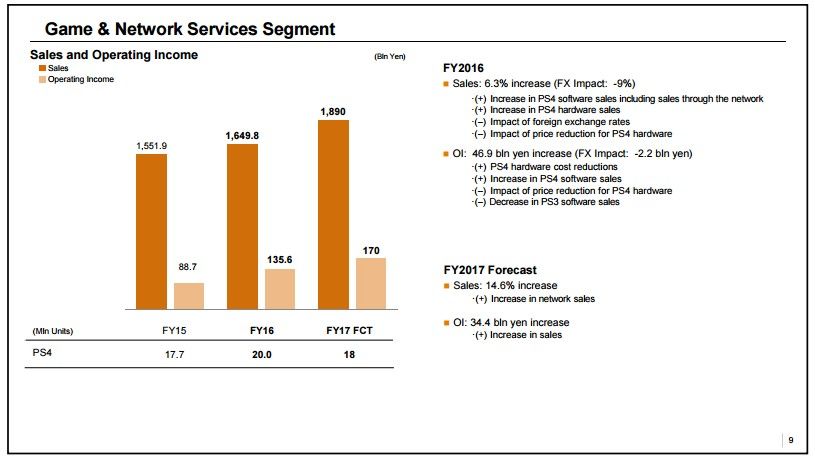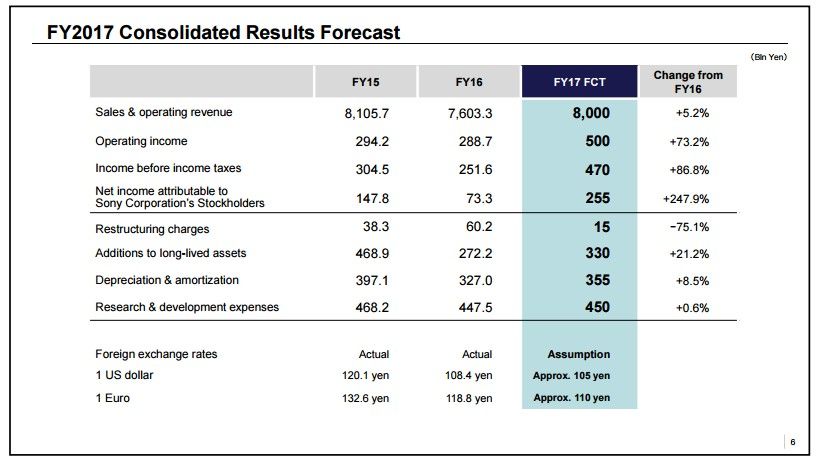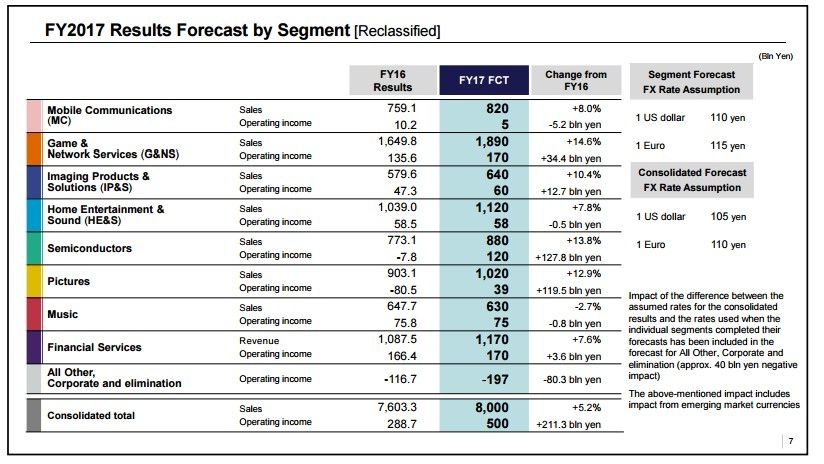Sony Corporation announced today its financial results for the fiscal year 2016, ended on March 31st, 2018, alongside those for the fourth quarter of the fiscal year (between January 1st and March 31st, 2017).
You can see a summary of the revenue and income figures in the table below. All the numbers are firmly in the black, while full fiscal year results are weaker compared to fiscal year 2015.
The accompanying press release included detailed information on the company's performance.
Sales and operating revenue (“Sales”) decreased by 6.2% compared to the previous fiscal year (“year-on-year”) to 7,603.3 billion yen (67,886 million U.S. dollars). This decrease was mainly due to the impact of foreign exchange rates. On a constant currency basis, sales were essentially flat year-on-year, due to significant increases in Game & Network Services (“G&NS”) and Semiconductors segment sales, substantially offset by a significant decrease in Mobile Communications (“MC”) segment sales. For further details about the impact of foreign exchange rates fluctuations on sales and operating income (loss).
Operating income decreased 5.5 billion yen year-on-year to 288.7 billion yen (2,578 million U.S. dollars). This decrease was mainly due to the 962 million U.S. dollars (112.1 billion yen) impairment charge of goodwill recorded in the Pictures segment, substantially offset by an improvement in the operating results of the MC segment and an increase in the operating income of the G&NS segment. Sony made a downward revision in the future profitability projection for the Motion Pictures business within the Pictures segment. Due to the revision, it was determined that the entire amount of goodwill, in the Production & Distribution reporting unit of the Pictures segment, which includes the Motion Pictures business, was impaired and an operating loss was recorded in the Pictures segment.
In addition, operating income in the current fiscal year included a 42.3 billion yen (378 million U.S. dollars) impairment charge related to the planned transfer of the battery business in the Components segment, a 23.9 billion yen (213 million U.S. dollars) impairment charge against long-lived assets resulting from the termination of the development and manufacturing of certain high-functionality camera modules for external sale in the Semiconductors segment, as well as net charges of 15.4 billion yen (137 million U.S. dollars) in expenses resulting from the earthquakes in the Kumamoto region in 2016 (“the 2016 Kumamoto Earthquakes”), also in the Semiconductors segment. The expenses resulting from the 2016 Kumamoto Earthquakes include 16.7 billion yen (149 million U.S. dollars) of repair costs for certain fixed assets and losses on disposal of inventories that were directly damaged (the “Physical Damage”), as well as 9.4 billion yen (84 million U.S. dollars) of idle facility costs at manufacturing sites. The expenses for the Physical Damage were partially offset by the recognition of 10.7 billion yen (95 million U.S. dollars) of probable insurance recoveries. Offsetting all of the above charges was a 37.2 billion yen (332 million U.S. dollars) gain on the sale of certain shares of M3, Inc. (“M3”) recorded in All Other.
Operating income in the previous fiscal year included a 59.6 billion yen impairment charge against long-lived assets in the camera module business in the Semiconductors segment, a 30.6 billion yen impairment charge against long-lived assets for the battery business in the Components segment, a 151 million U.S. dollars (18.1 billion yen) gain in the Music segment on the remeasurement to fair value of Sony Music Entertainment’s (“SME”) 51% equity interest in Orchard Media, Inc. (“The Orchard”), which had previously been accounted for under the equity method, as a result of SME increasing its ownership interest to 100%, as well as a gain of 12.3 billion yen from the sale of a part of the logistics business, in connection with the formation of a logistics joint venture, recorded in Corporate and elimination.
During the current fiscal year, restructuring charges, net, increased 22.0 billion yen year-on-year to 60.2 billion yen (538 million U.S. dollars) primarily due to the above-mentioned impairment charge related to the planned transfer of the battery business. This amount is recorded as an operating expense included in the above-mentioned operating income.
Of course, we get an update on PS4 shipments: the console shipped 20 million units in fiscal year 2016 (which is exactly in line with the company's predictions announced last year). This brings the total of shipments to 60 million units by March 31st.
Sony also provided a specific breakdown of the results of the Game & Network Services segment of the business, which includes PlayStation and PlayStation Network. We see an increase in PS4 software and hardware sales year-on-year, partially offset by PS4 price cuts.
PS4 hardware manufacturing costs were also reduced, determining a significant increase in operating income year-on-year, partly offset by price cuts and lower PS3 software sales.
Sales increased 6.3% year-on-year (a 16% increase on a constant currency basis) to 1,649.8 billion yen (14,730 million U.S. dollars). This increase was primarily due to an increase in PlayStation®4 (“PS4”) software sales, including sales through the network, as well as an increase in PS4 hardware sales, partially offset by the impact of foreign exchange rates and the impact of a price reduction for PS4 hardware.
Operating income increased 46.9 billion yen year-on-year to 135.6 billion yen (1,210 million U.S. dollars). This significant increase was primarily due to PS4 hardware cost reductions and the above-mentioned increase in PS4 software sales, partially offset by the impact of the price reduction for PS4 hardware and a decrease in PlayStation®3 software sales. During the current fiscal year, there was a 2.2 billion yen negative impact from foreign exchange rate fluctuations.
Last, but not least, we get the forecast for the current fiscal year, ending on March 31st, 2018, both for the company as a whole, and split by segment.
The outlook for the Game & Network Services includes a 15.6% year-on-year increase in sales to 1,890 billion yen mostly focused on PlayStation Network sales, while operating income should increase by 34.4 billion yen to 170 billion yen.
Of particular interest is the forecast of PS4 shipments for the whole fiscal year 2017, which is set at 18 million units. This means that Sony predicts lifetime PS4 shipments to be at 78 million by March 31st, 2018.
If you want to compare results with the previous quarter (between October 1st 2016 and December 31st) you can check them out here.


